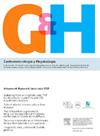The endoscopic model for gastric carcinogenesis and Helicobacter pylori infection: A potential visual mind-map during gastroscopy examination
IF 2.2
4区 医学
Q3 GASTROENTEROLOGY & HEPATOLOGY
引用次数: 0
Abstract
Helicobacter pylori (Hp) is the main trigger of chronic gastric atrophy and the main leading cause of gastric cancer. Hp infects the normal gastric mucosa and can lead to chronic inflammation, glandular atrophy, intestinal metaplasia, dysplasia and finally adenocarcinoma. Chronic inflammation and gastric atrophy associated with Hp infection appear initially in the distal part of the stomach (the antrum) before progressing to the proximal part (the corpus–fundus). In recent years, endoscopic developments have allowed for the characterization of various gastric conditions including the normal mucosa (pyloric/fundic gland pattern and regular arrangement of collecting venules), Hp-related gastritis (Kyoto classification), glandular atrophy (Kimura–Takemoto classification), intestinal metaplasia (Endoscopic Grading of Gastric Intestinal Metaplasia), and dysplasia/adenocarcinoma (Vessel plus Surface classification). Despite being independent classifications, all these scales can be integrated into a single model: the endoscopic model for gastric carcinogenesis. This model would assist endoscopists in comprehending the process of gastric carcinogenesis and conducting a systematic examination during gastroscopy. Having this model in mind would enable endoscopists to promptly recognize the implications of Hp infection and the potential patient's risk of developing gastric cancer.
胃癌和幽门螺旋杆菌感染的内窥镜模型:胃镜检查中的潜在视觉思维导图。
幽门螺杆菌(Hp)是胃慢性萎缩的主要诱因,也是胃癌的主要致病原因。Hp 感染胃正常粘膜后,可导致慢性炎症、腺体萎缩、肠化生、发育不良,最终导致腺癌。与 Hp 感染相关的慢性炎症和胃萎缩最初出现在胃的远端(胃窦),然后发展到近端(胃底)。近年来,内镜技术的发展使各种胃病的特征得以确定,包括正常粘膜(幽门/胃底腺体形态和规则排列的集合静脉)、与 Hp 相关的胃炎(京都分类)、腺体萎缩(木村-竹本分类)、肠化生(胃肠化生的内镜分级)和发育不良/腺癌(血管加表面分类)。尽管所有这些分级都是独立的,但可以整合成一个模型:胃癌发生的内镜模型。该模型有助于内镜医师理解胃癌发生的过程,并在胃镜检查中进行系统检查。有了这一模型,内镜医师就能及时发现 Hp 感染的影响以及潜在患者罹患胃癌的风险。
本文章由计算机程序翻译,如有差异,请以英文原文为准。
求助全文
约1分钟内获得全文
求助全文
来源期刊

Gastroenterologia y hepatologia
GASTROENTEROLOGY & HEPATOLOGY-
CiteScore
1.50
自引率
10.50%
发文量
147
审稿时长
48 days
期刊介绍:
Gastroenterology and Hepatology is the first journal to cover the latest advances in pathology of the gastrointestinal tract, liver, pancreas, and bile ducts, making it an indispensable tool for gastroenterologists, hepatologists, internists and general practitioners.
 求助内容:
求助内容: 应助结果提醒方式:
应助结果提醒方式:


